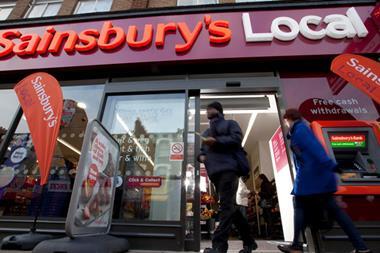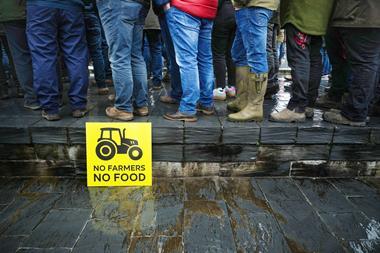The costly and ill-fated automated ‘picking’ system that was at the heart of Sainsbury’s availability woes until recent years has remained a heavy burden on operating efficiency and looks set to be ripped out altogether.
In a week when underperformance against its big four rivals saw Sainsbury’s shares fall to a 52-week low of 350p on Wednesday, it was claimed that CEO Justin King had been using “sticky plaster” and high levels of costly temporary labour to make up for the errors that plagued the automated fulfilment system of picking goods. Installed in the Sir Peter Davis regime in 2003, a source at the time told The Grocer that barcode reading errors were “horrendous”.
In 2004 the then new chief executive Justin King highlighted availability as Sainsbury’s biggest performance issue and pumped in extra labour to cover for the automated system’s shortfalls. But despite improved availability the depots have never operated efficiently, according to several sources.
Prior to Christmas, Sainsbury’s completed the removal of the automated systems at its distribution centre in Waltham Point and the London depot was already showing signs of improved picking accuracy, said one company insider.
Sainsbury’s is now reviewing Waltham Point’s performance before deciding whether to ditch the system at its second major RDC in Hams Hall, Birmingham, which was the first depot to get the automated system. “We are proposing to make changes, but nothing has been finalised or confirmed,” said a Sainsbury’s spokeswoman.
Waltham Point’s ambient order picking is now fully manual, as is chilled picking, although chilled sorting remains automated. If Sainsbury’s is satisfied that order picking has improved it will introduce the same systems in Birmingham.
“Hams Hall is not working and needs to change,” said the insider. “It’s only by hook or by crook that we still manage to get stock out to stores.” Hams Hall was running at a loss and a raft of agency workers were continuously being drafted in to rectify the automated system’s persistent picking errors, he added. Sainsbury’s is in negotiations with the Unite union about arrangements for 1,300 drivers and warehouse workers at the depot ahead of the changeover.
It is believed 350 workers – a third of the DC’s warehouse staff – would temporarily move to a satellite depot in Tamworth, 12 miles away. “We are in early talks but are hopeful we can overcome all obstacles to help Sainsbury’s complete the changes,” said Joe Clarke of the T&G section of Unite for food and drink, Birmingham.
The internal source said Sainsbury’s had earmarked £12m to make the changes at Hams Hall, but a logistics expert added that the major losses had already been accounted for when Justin King wrote off £250m in 2005.
In a week when underperformance against its big four rivals saw Sainsbury’s shares fall to a 52-week low of 350p on Wednesday, it was claimed that CEO Justin King had been using “sticky plaster” and high levels of costly temporary labour to make up for the errors that plagued the automated fulfilment system of picking goods. Installed in the Sir Peter Davis regime in 2003, a source at the time told The Grocer that barcode reading errors were “horrendous”.
In 2004 the then new chief executive Justin King highlighted availability as Sainsbury’s biggest performance issue and pumped in extra labour to cover for the automated system’s shortfalls. But despite improved availability the depots have never operated efficiently, according to several sources.
Prior to Christmas, Sainsbury’s completed the removal of the automated systems at its distribution centre in Waltham Point and the London depot was already showing signs of improved picking accuracy, said one company insider.
Sainsbury’s is now reviewing Waltham Point’s performance before deciding whether to ditch the system at its second major RDC in Hams Hall, Birmingham, which was the first depot to get the automated system. “We are proposing to make changes, but nothing has been finalised or confirmed,” said a Sainsbury’s spokeswoman.
Waltham Point’s ambient order picking is now fully manual, as is chilled picking, although chilled sorting remains automated. If Sainsbury’s is satisfied that order picking has improved it will introduce the same systems in Birmingham.
“Hams Hall is not working and needs to change,” said the insider. “It’s only by hook or by crook that we still manage to get stock out to stores.” Hams Hall was running at a loss and a raft of agency workers were continuously being drafted in to rectify the automated system’s persistent picking errors, he added. Sainsbury’s is in negotiations with the Unite union about arrangements for 1,300 drivers and warehouse workers at the depot ahead of the changeover.
It is believed 350 workers – a third of the DC’s warehouse staff – would temporarily move to a satellite depot in Tamworth, 12 miles away. “We are in early talks but are hopeful we can overcome all obstacles to help Sainsbury’s complete the changes,” said Joe Clarke of the T&G section of Unite for food and drink, Birmingham.
The internal source said Sainsbury’s had earmarked £12m to make the changes at Hams Hall, but a logistics expert added that the major losses had already been accounted for when Justin King wrote off £250m in 2005.



















No comments yet